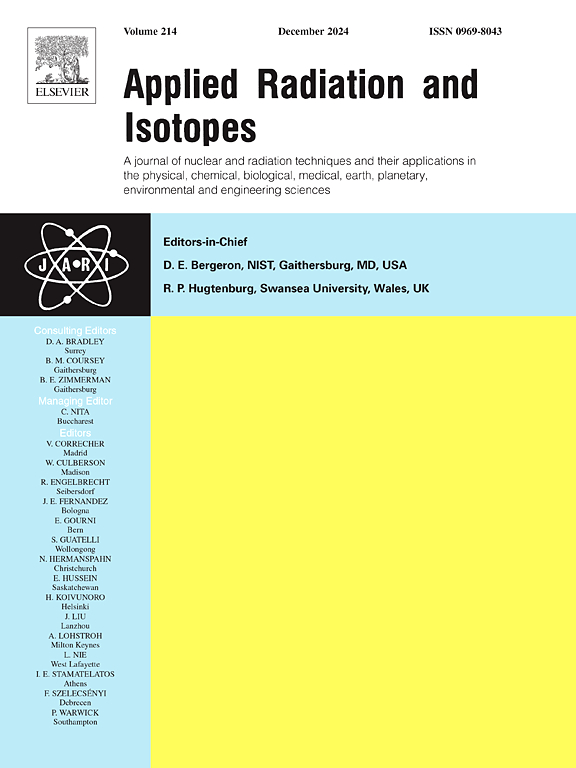用于医疗应用的 225Ac/213Bi 放射性核素发生器的气体化学方法。
IF 1.6
3区 工程技术
Q3 CHEMISTRY, INORGANIC & NUCLEAR
引用次数: 0
摘要
文章介绍了一种新颖的 225Ac/213Bi 发生器气体化学方法,可有效地从母体 225Ac 中分离出 213Bi。高活性发生器的主要问题是吸附剂的辐射稳定性,而这种气体化学分离方法只使用辐射稳定的无机材料,因此吸附剂的辐射稳定性并不重要。这种方法包括在含氢的惰性气体流中对沉积在衬底材料(铌、石英玻璃、不锈钢)上的 225Ac 样品进行高温加热(约 900-1000 ℃)。在这种条件下,锕不会挥发,而璧则会升华,并沿着温度梯度沉积在捕集器箔片上。研究发现,铌是起始衬底和捕集箔的最佳材料。计算得出铌衬底上无载流子量铋升华的有效活化能为 102 ± 9 kJ/mol,根据热色谱数据评估得出铋在铌上的标准解吸焓为 269 ± 13 kJ/mol 213Bi 可以通过从捕集器膜表面清洗回收,用于随后制备放射性药物。气体化学方法已被证明是一种很有前途的 225Ac/213Bi 发生器方法,可用于α靶向治疗。本文章由计算机程序翻译,如有差异,请以英文原文为准。
Gas-chemical approach to 225Ac/213Bi radionuclide generator for medical application
The article presents a novel gas-chemical approach for 225Ac/213Bi generators, which provides effective separation of 213Bi from parent 225Ac. The main problem with the generators of high activity is the radiation stability of sorbents, which is not substantial in this gas-chemical method of separation, where only radiationally stable inorganic materials are used. The approach includes heating at high temperature (about 900–1000 °C) 225Ac sample deposited on a backing material (Nb, quartz glass, stainless steel) in hydrogen-containing inert gas flow. Actinium is non-volatile in these conditions, while Bi sublimes and is deposited on a catcher-foil along a temperature gradient. Niobium was found to be the best of the used material for both the starting backing and catcher-foil. The effective activation energy of carrier-free amount of Bi-sublimation from Nb-backing as 102 ± 9 kJ/mol has been calculated, and standard enthalpy of desorption of Bi on Nb from thermochromatographic data has been evaluated as 269 ± 13 kJ/mol 213Bi may be recovered for the consequent preparation of radiopharmaceuticals by washing from the catcher-foil surface. The gas-chemical method has been demonstrated to be a promising approach for 225Ac/213Bi generators for its application in targeted alpha therapy.
求助全文
通过发布文献求助,成功后即可免费获取论文全文。
去求助
来源期刊

Applied Radiation and Isotopes
工程技术-核科学技术
CiteScore
3.00
自引率
12.50%
发文量
406
审稿时长
13.5 months
期刊介绍:
Applied Radiation and Isotopes provides a high quality medium for the publication of substantial, original and scientific and technological papers on the development and peaceful application of nuclear, radiation and radionuclide techniques in chemistry, physics, biochemistry, biology, medicine, security, engineering and in the earth, planetary and environmental sciences, all including dosimetry. Nuclear techniques are defined in the broadest sense and both experimental and theoretical papers are welcome. They include the development and use of α- and β-particles, X-rays and γ-rays, neutrons and other nuclear particles and radiations from all sources, including radionuclides, synchrotron sources, cyclotrons and reactors and from the natural environment.
The journal aims to publish papers with significance to an international audience, containing substantial novelty and scientific impact. The Editors reserve the rights to reject, with or without external review, papers that do not meet these criteria.
Papers dealing with radiation processing, i.e., where radiation is used to bring about a biological, chemical or physical change in a material, should be directed to our sister journal Radiation Physics and Chemistry.
 求助内容:
求助内容: 应助结果提醒方式:
应助结果提醒方式:


